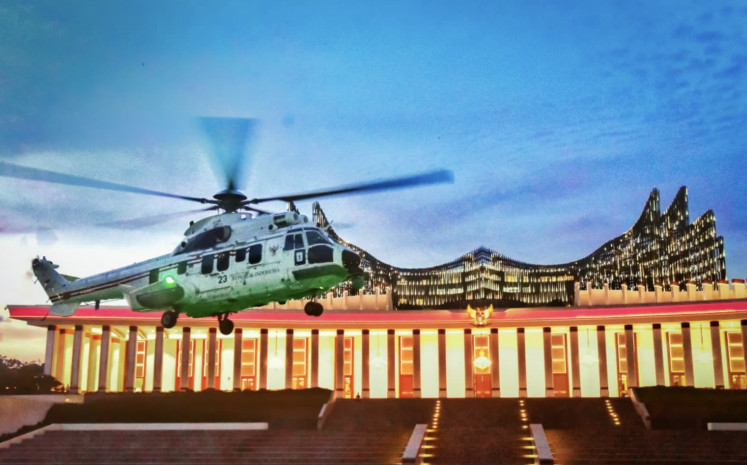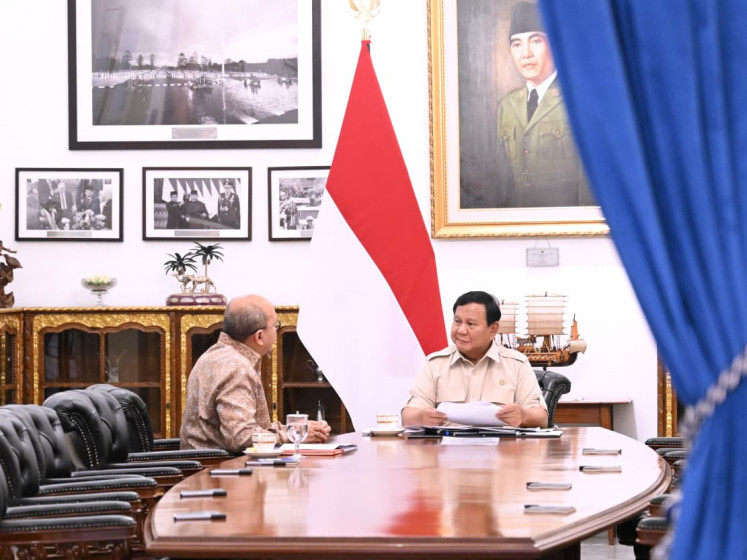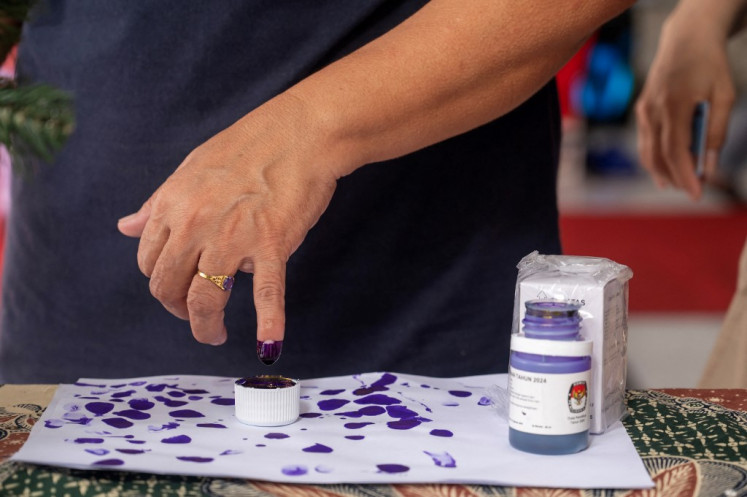Popular Reads
Top Results
Can't find what you're looking for?
View all search resultsPopular Reads
Top Results
Can't find what you're looking for?
View all search resultsFreiburg, the Green City
A view of the Freiburg’s Old Town and vineyards
Change text size
Gift Premium Articles
to Anyone
A view of the Freiburg’s Old Town and vineyards. Photo by Triwik Kurniasari
The warmest city in southwest Germany offers a bunch of fascinating attractions for visitors — refreshing green areas, a captivating old town, unique cuckoo clocks and delightful black forest cake.
“Many Germans want to live in Freiburg. Why? You will find out the answer once we get there very soon,” said Hannelore Hippe on the bus on our way from Nuremberg to Freiburg.
Hanna, a German journalist who accompanied me and some fellow journalists on an excursion to Freiburg, was right.
Shadowy forests and a river landscape were clearly seen on a bright afternoon at the beginning of summer time in Germany. It is one of the sunniest cities in Germany with a scorching 1,740 hours of sunshine per year.
Located in the famous Schwarzwald (Black Forest) area in Baden-Württemberg region, Freiburg is widely known as an ecological city in the region bordering France and Switzerland. The clean image began in the 1970s, when the region of Baden-Wurttemberg planned to build a nuclear power station near Freiburg.
There was a campaign against the idea and the plans were later abandoned following the nuclear disaster at Chernobyl in 1986. Since then, solar energy has become the principal new source of energy and solar panels can be found on the roofs of the Badenova soccer stadium, schools, churches and private houses.
In 1992, Freiburg was chosen as Germany’s “Environmental Capital” for its pioneering achievements such as the installation of early-warning systems for smog and ozone pollution, pesticide bans and recycling measures.
The Black Forest metropolis, which has a population of more than 215,000 inhabitants as of March 2006, is visited by over 500,000 hotel guests and over three million day tourists annually. Right after we arrived in the city, we made our way to explore what Freiburg has to offer.
A small vineyard in the garden of the Archaeological museum. — Photo by Triwik Kurniasari
The historic old town
The starting point of the sightseeing tour is a walk through Freiburg’s Altstadt (Old Town). It is fairly easy to get around on foot since the Old Town is near both the train and bus stations.
The first thing that might catch your eyes as you enter the historical area is the Freiburg bächle (small canals).
Originally used for the provision of water for sewers and industrial purposes, today, the water runnels are a popular recreation area for adults and children who want to soak their feet during a scorching hot day. Some people can be seen walking through the runnels, enjoying themselves dipping in the cold yet fresh water.
Cast your eyes to the right and left, where clothing and souvenir shops, eateries and ice cream outlets can be found easily in the area alongside the city’s museums and magnificent historical buildings.
Check out Altes Rathaus (Old Town Hall) on the Rathausplatz, which now functions as a tourist information center, the Neues Rathaus (New Town Hall), Haus zum Walfisch (Whale House) with its impressive, late-gothic portal oriel and Basler Hof (Basle Court), situated in the main street Kaiser-Joseph-Strasse.
From afar, we can catch a glimpse of a fine tower above the rooftops of the numerous old buildings. The 116-meter-high tower is none other than the most-visited Münster, a Gothic style cathedral the construction of which was started in 1200 and was completed by 1330, in the Münsterplatz.
Parts of the cathedral’s architecture are beautifully adorned with sculptures and gargoyles in the form of prophets, saints, demons and imps.
To the south, we can see, standing tall, the Martinstor (St. Martin’s Gate), a gate tower built at the beginning of the 13th century.
Spare some time to take a look at the beautiful view of the Black Forest capital and the Rhine valley by heading to the Schlossberg, the upper part of the city which can be reached by foot in a few
minutes from the Old Town.
Follow the signposts along the way up to the Schlossberg where you can see the best sunset in the city.
The Schlossberg is surrounded by green areas where you can lie down on the grass in the shade while having a chit chat with your friends, reading your favorite books or even taking a nap.
Strong feet and sturdy footwear are needed if you decide to climb up the hill. But after you get to the top, all the sweat is worth it since it is a perfect place to enjoy Freiburg far from the town’s hustle and bustle.
If you want to take a rest for a minute while sipping beer or a cup of coffee and having something to eat, you can also stop in a cafe in the hilly area.
Home of cuckoo clock
Want an original made-in-Freiburg souvenir? A cuckoo clock can be a good idea. It is basically a pendulum driven clock that imitates the call of the grayish brown European bird the cuckoo.
The history of the famous clock dates back centuries when poorer Black Forest people struggled to find part-time work since their income was not enough to support their families.
In 1640, they began to manufacture simple wooden clocks, equipped only with one hand to indicate the time.
A visitor takes a look at Freiburg’s cuckoo clocks, which can be found in every souvenir shop around the city. Photo by Triwik Kurniasari
About 100 years later, the first Black Forest cuckoo clock was invented and within a few decades, this clock was incredibly popular throughout the world.
The design is usually a miniature of a Black Forest house with a moving lumberjack, carvings and a wooden dial with an automatic night-shut-off so as not to bother your sleep at night.
A mechanical cuckoo clock costs more than ¤100 (US$144). The prices depend on the detail of the carvings, the music and additional figurines.
Before deciding to buy one, make sure that the product has a certification of originality, which states that the clocks were made in Germany’s Black Forest.
If you don’t want to spend that amount of money and carry a big heavy clock in your luggage, you can buy the smaller version or a cuckoo clock fridge magnet.
Another original souvenir is a Black Forest porcelain doll with red pompoms on a straw hat, which can be a lovely gift for your kids or nieces.
Wine and dine
Before we roamed around the city, Hanna reminded us not to miss out on Freiburg’s very own black forest cake.
Locals and visitors enjoy glasses of wine at the Freiburg Wine Festival, held annually every July in Münsterplatz or Cathedral square. Photo by Triwik Kurniasari
A nice gentleman who owned a souvenir shop near the cathedral advised us to go to a certain cake shop to taste the best black forest cake in town.
A big slice of black forest cake costs around ¤2. The cake, layered with chocolate sponge and decorated with fresh cherries and whipped cream, tasted light and not overly sweet.
Those who prefer something more substantial can go to the Markthalle (Market Hall), next to the Martinsor.
There, dozens of food stall owners offer a selection of food and beverages, from wine, fresh fruit and vegetables to international dishes like Italian delights, Indian specialties and Thai cuisine which are all prepared fresh.
To accompany your lunch or dinner, a glass of wine would be the best bet since the municipality of Freiburg has dubbed itself as a city of wine due to its prolific yet large vineyards. On the first week in July, an annual wine festival is held in the Münsterplatz, which turns into a tempting display of different Baden wine varieties.
Those who miss Freiburg’s wine festival still have an enjoyable opportunity to sample a variety of wines at bars and restaurants around the city.
Visit Vauban, the ecological area
One of the interesting districts in Freiburg is Vauban, an attractive ecological quarter with a solar-powered low-energy housing complex.
The Vauban quarter was established in an area of 38 hectares located close to the city center, on the land where a French military barracks once stood.
Stroll down into the area and you will find some environmentally friendly points in the neighborhood which is inhabited by around 6,000 people.
The houses have vegetation-covered flat roofs that store rainwater, which is collected and reused; they also have solar panels installed. Rows of old big trees and green spaces are familiar views in the quarter, providing play areas for children.
Vauban also has many “passive” houses, built in a way that they do not need energy for cooling during summer or heating during winter.
The infrastructure encompasses schools, youth facilities and a marketplace as well as spaces for recreation.
The district is traffic-calmed, with the majority of households not owning cars. Since 2006, the housing complex has been linked to the city tram system, which enables the residents to go to other parts of the city without a car.
Tips and tricks
Getting there:
By air: Visitors arriving in the city land at the Euro Airport Basel-Mulhouse-Freiburg, which is 70 kilometers from Freiburg and within 45 minutes by bus and shuttle connection. There are over 450 scheduled flights per week to 50 different destinations throughout Europe, including Berlin, Hamburg, London, Paris, Prague, Madrid, Barcelona, Rome, Stockholm, Reykjavik and many more.
By train: with Intercity-Express, with hourly Intercity and Eurocity trains.
By bus: There are buses from Karslruhe, Nuremberg, and Stuttgart.
Getting around:
•The best way to get around the Old Town is by foot.
•If you want to go to other districts, you can simply hop on a bus or tram by using a Regio Fahrkarte (regional public transportation ticket). You can buy tickets at the tourist information or papeterie kiosks. For more information on the routes and ticket points of sale, log on to
www.vag-freiburg.de.
•Another option is cycling as Freiburg’s location in the upper Rhine makes it an ideal climate for bike riding. Visitors can rent bikes at Mobile, bicycle station and mobility center, at the main train station (Hauptbahnhof).













